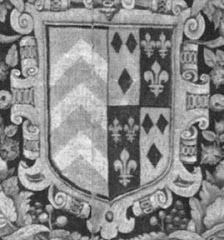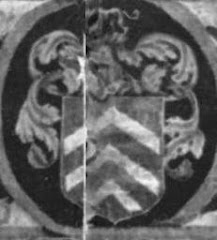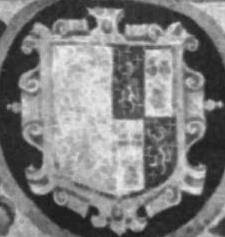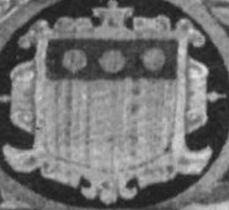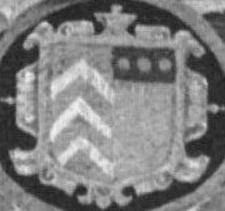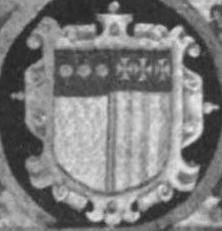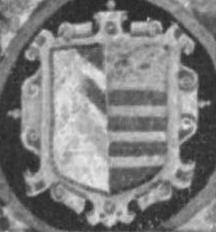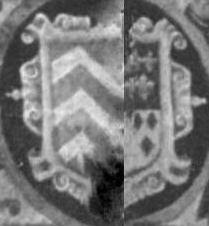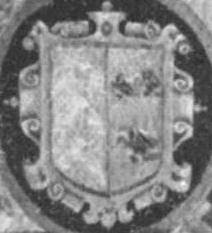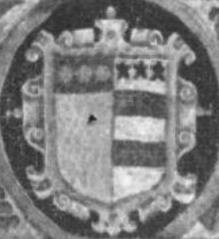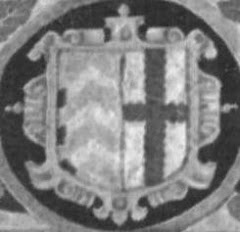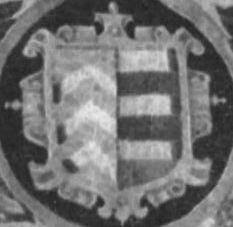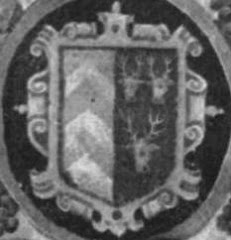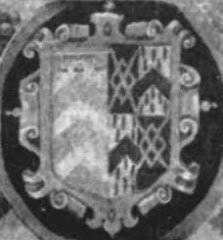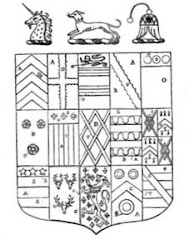She writes:
The supposed “James Blount” Bookplate
As I write this, in May 2017, it is almost 20 years since I was first
asked by the late Kyle VanLandingham, knowing that I would be in North
Worcestershire, to check out the veracity of the claim that James Blount,
son of Thomas Blount of Astley, Worcestershire, had married into the Clare
family of Kidderminster.
I found no evidence of any such.
Kyle then asked whether there was any evidence of James Blount (died
before 1655) having married into a family called Lewkenor. The only mention of
that name that I found in Worcestershire Record Office, then at County Hall,
was the 1580 will of Nicholas Lewkenor, which mentioned a Richard Lewkenor of
Sussex. There might have been other mentions with one of the several spelling
variants, e.g. Leuknor, but I knew nothing of this spelling at that time.
I visited the West Sussex Record Office at Chichester where I found a
host of Lewkenors.
Both Kyle and our fellow sleuth, Bromfield Nichol, have since died, and
I have done little research into the Blounts, until six months ago, when I was
asked by another researcher for my opinion on the “James Blount – Clare
marriage”. I revisited all known information but, again, I still I found no
such marriage.
In the course of our exchanges, my contact sent me a copy of page 17 of
Bolton’s “An American Armory”, published 1927, which was new to me, and I
believe that I now understand the Clare marriage theory.
This page has two entries for Blount:
- “Blount: (Or) 3 fruited twigs in pale fessways
(sa). Impaling: (Or) 3 chevrons (gu) (Claire).
Crests: 1: sun in splendor; 2. A stag’s head cabossed.
Seal owned by Mrs.Charles G.Irish of Utica, N.Y., used by her great grandfather Jacob Blount of North Car. Should be 3 bars nebulae?
Bookplate James Blount of Carolina about 1740. Painting owned by Miss Lena Smith, Scotland Neck, N.C.” - “Blount: Or 3 bars nebulae sa (should be Barry
nebulae or and sa). Impaling: 3 fleurs-de-lis (Mountford?).
Crests: 1. A sun in splendor; 2: feathers.
Painting owned by Miss Lena Smith, Scotland Neck, N.C.”
Miss Lena Smith was a contemporary of Miss Helen Prescott, who visited
England in 1902, the year in which she published her genealogical chart “Blount
and Blunt”, which can be seen on lamartin.com. She visited England with the
*expectation* of finding a James Blount – (unknown given name) Clare, but never
found this. Miss Prescott also added dates – as I think she found them – to her
chart, which should be taken with care, e.g. she gave the date of death of the
older James as 1655 and that this death took place at the Battle of Worcester,
“in 1655” . We know from the will of his half-brother, Charles, dated 1655, (lamartin.com)
that James senior was dead by then. Miss Prescott was proposing the battle
(which, of course, took place sin 1651) as a possible cause of death for James;
again, there is no evidence.
- There were two James Blounts connecting the
Astley family with Virginia: the “gateway ancestor” and his father. The
identity of the father’s wife is not known – neither is the identity of
his mother. I keep reading on the internet that the older James’ mother
was Bridget Brome – she was his stepmother, his father’s
second wife. It is clear from Thomas Blount’s will (on lamartin.com),
that James was NOT his son by Bridget. This is also confirmed by the first
will of Bridget (by then Bridget Stanley), 1636, Worcester (England)
County Record Office, in which she leaves five shillings to each of her
children and to James Blount her son-in-law (stepson) (lamartin.com).
Unfortunately, the surname of James senior’s first wife is not known.
- The bookplate design can be easily dated to
the latter part of the 17thC through its Chippendale design surround. The
name “James Blount” is a further addition.
Descent from Walter Blount of Astley
Walter Blount of Astley, Worcestershire, d 1561, 3rd son of
Sir Thomas Blount, d 1524 of Kinlet
Robert Blount of Astley, d 1573
Thomas Blount of Astley, will dated 1624 m 1. Unknown, 2. Bridget Broome
James Blount, d before 1655 (son of Thomas by first, unknown wife)
Capt.James Blount, settled N.Carolina (will, dated 1686, signed with seal (lamartin.com)
Thomas Blount of Tyrell County, North Carolina, d 1706, m 2. Mary Perry/Scott
Thomas Blount 1687-1729 m Anne Reading
Capt.Jacob Blount, 1726-1789, of Blount Hall, Beaufort, signed will with seal, m Barbara Gray
William Blount, 1749-1800, Governor of the Territory South of the Ohio. Founded Knoxville.
John H.Wheeler writing in “Reminiscences and Memoirs of North
Carolina and Eminent North Carolinians”, Columbus, OH, 1884, stated: “Miss
Helen Malvina Blount Prescott, in her unpublished manuscript genealogy of the
descendants of Capt. James Blount said the following: ‘The Coat of Arms (said
to have been taken from his tomb) (What tomb !?) engraved as
a copper plate, was in the possession of his descendant James B.Sheppard of
Raleigh and destroyed by him about 1840.’”
Putting everything together:
- James Blount, the ‘Gateway Ancestor’, signed
his will with a seal. James was entitled to the arms of the Blounts: the
Kinlet and Kidderminster Blount families having died out in the male line.
Could the bizarre, but recognizable, design on the left hand side of the
supposed “coat of arms” have been taken from a signet-ring home-made
seal?
- This proposed home-made seal might then have
been used on Capt.Jacob Blount’s will in 1789.
- Governor William Blount would, obviously, not
have used a home-made seal.
- James B.Sheppard of Raleigh is said to have
destroyed “the plate” about 1840.
- The surround of the supposed “coat of arms” is
in the “Chippendale” style, popular in the later 1700s and is presumably
as on the painting owned a century later by Miss Lena Smith.
- In the 1800s the study of heraldry became very
popular. “English Heraldry” by Charles Boutel, pub. London and New York in
1867, makes many references to “Clare”, but none to “Lewkenor” nor to any
of its spelling variants. Lewknor (sic) was proposed by the late Brom
Nichol, based on his comparison of Fairbairn’s Crests (pub 1905) with
other heraldic sources. At about 1610 Sir Lewes Lewkenor, King James I’s
“Master of the Ceremonies” married Mary Blount of Dedisham (of
Mountjoy-Mapledurham descent), whose mother was first cousin to the West
brothers and, of course, Lord de la Warr, but I have found no Blount
husband for any Lewkenor lady.
Did someone in this family have a book with a bookplate inside showing
the arms of the Lewkenors? Was it believed that this book with its bookplate
came from some ancestor in the past? Or is this a complete red herring? There
is, sadly, a great deal of totally wrong information circulating on the
internet.
The “bookplate” story needs to stay a mystery until someone is fortunate
enough to understand it.
With best wishes, G




